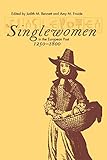Singlewomen in the European Past, 1250-1800 / Amy M. Froide, Judith M. Bennett.
Material type: TextPublisher: Philadelphia : University of Pennsylvania Press, [2013]Copyright date: ©1999Description: 1 online resource (360 p.)Content type:
TextPublisher: Philadelphia : University of Pennsylvania Press, [2013]Copyright date: ©1999Description: 1 online resource (360 p.)Content type: - 9780812216684
- 9780812200218
- 305.48/9652/094 21
- HQ800.2 .S56 1999eb
- online - DeGruyter
- Issued also in print.
| Item type | Current library | Call number | URL | Status | Notes | Barcode | |
|---|---|---|---|---|---|---|---|
 eBook
eBook
|
Biblioteca "Angelicum" Pont. Univ. S.Tommaso d'Aquino Nuvola online | online - DeGruyter (Browse shelf(Opens below)) | Online access | Not for loan (Accesso limitato) | Accesso per gli utenti autorizzati / Access for authorized users | (dgr)9780812200218 |
Browsing Biblioteca "Angelicum" Pont. Univ. S.Tommaso d'Aquino shelves, Shelving location: Nuvola online Close shelf browser (Hides shelf browser)

|

|

|

|

|

|

|
||
| online - DeGruyter Educating for Human Dignity : Learning About Rights and Responsibilities / | online - DeGruyter Human Rights in Cross-Cultural Perspectives : A Quest for Consensus / | online - DeGruyter Dreams of Fiery Stars : The Transformations of Native American Fiction / | online - DeGruyter Singlewomen in the European Past, 1250-1800 / | online - DeGruyter Reading the Qur'ān in Latin Christendom, 1140-1560 / | online - DeGruyter Writing the Image After Roland Barthes / | online - DeGruyter Holy Wednesday : A Nahua Drama from Early Colonial Mexico / |
Frontmatter -- Contents -- Acknowledgments -- 1. A Singular Past -- 2. Singlewomen in Medieval and Early Modern Europe -- 3. "It Is Not Good That [Wo] man Should Be Alone" -- 4. Single by Law and Custom -- 5. Sex and the Singlewoman -- 6. Transforming Maidens -- 7. Having Her Own Smoke -- 8. Singlewomen in Early Modern Venice -- 9. Marital Status as a Category of Difference -- 10. The Sapphic Strain -- 11. Singular Politics -- Appendix. Demographic Tables -- Contributors -- Index
restricted access online access with authorization star
http://purl.org/coar/access_right/c_16ec
When we think about the European past, we tend to imagine villages, towns, and cities populated by conventional families-married couples and their children. Although most people did marry and pass many of their adult years in the company of a spouse, this vision of a preindustrial Europe shaped by heterosexual marriage deceptively hides the well-established fact that, in some times and places, as many as twenty-five percent of women and men remained single throughout their lives.Despite the significant number of never-married lay women in medieval and early modern Europe, the study of their role and position in that society has been largely neglected. Singlewomen in the European Past opens up this group for further investigation. It is not only the first book to highlight the important minority of women who never married but also the first to address the critical matter of differences among women from the perspective of marital status.Essays by leading scholars-among them Maryanne Kowaleski, Margaret Hunt, Ruth Mazo Karras, Susan Mosher Stuard, Roberta Krueger, and Merry Wiesner-deal with topics including the sexual and emotional relationships of singlewomen, the economic issues and employment opportunities facing them, the differences between the lives of widows and singlewomen, the conflation of singlewomen and prostitutes, and the problem of female slavery. The chapters both illustrate the roles open to the singlewoman in the thirteenth through eighteenth centuries and raise new perspectives about the experiences of singlewomen in earlier times.
Issued also in print.
Mode of access: Internet via World Wide Web.
In English.
Description based on online resource; title from PDF title page (publisher's Web site, viewed 23. Jul 2020)


